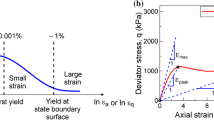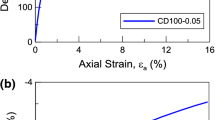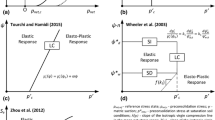Abstract
This study presents an evaluation of yielding mechanisms for unsaturated, compacted silt using drained triaxial compression tests with control of elevated temperatures and high suction magnitudes. After anisotropic compression, some compacted silt specimens were heated by approximately 40 °C before a suction of approximately 300 MPa was applied, while others were heated after suction application. A frictional response was observed for the specimens sheared under high suction magnitudes, in the form of a consistent increase in peak shear strength with increasing net confining stress. An effective stress analysis was used to evaluate the trends in the peak shear stress and the role of stress history for the different specimens. A single peak failure envelope was observed when the shear strength data was interpreted in terms of the mean effective stress. Changes in preconsolidation stress were estimated by identifying the intersections between a thermo-elasto-plastic yield function and the experimental peak shear strength values. Soil specimens heated before application of high suction values had lower peak shear strengths than reference specimens at high suction and ambient temperature. This behaviour is consistent with thermal softening trends observed in soils heated under low suction values. However, soil specimens heated after suction application had greater peak shear strengths than the reference specimens. This indicates heating under high suction results in hardening. The impact of suction on the preconsolidation stress was found to be better represented by a power law model at high suction magnitudes than other available models. The estimated preconsolidation stress values were used to evaluate the impacts of stress history on the thermal volume change response, which matched well with data from tests on saturated specimens.










Similar content being viewed by others
Abbreviations
- a:
-
Empirical parameter of the power law model
- b:
-
Empirical parameter of the power law model
- MW :
-
Molecular mass of water vapour
- MCSL :
-
Slope of the critical state line
- Mpeak :
-
Slope of the peak failure envelope
- N:
-
Reference specific volume point on the virgin compression line
- p:
-
Mean total stress
- p′:
-
Mean effective stress
- \({\text{p}}_{\text{c}}^{\prime }\) :
-
Mean effective preconsolidation stress
- \({\text{p}}_{\text{co}}^{\prime }\) :
-
Initial mean effective preconsolidation stress
- pn :
-
Mean net stress
- \({\text{p}}_{\text{peak}}^{\prime }\) :
-
Mean effective stress at peak failure
- qpeak :
-
Principal stress difference at peak failure
- Rh :
-
Relative humidity of the pore air in decimal form
- R:
-
Universal (molar) gas constant
- r:
-
Spacing ratio parameter of the Uchaipichat (2005) model
- ra :
-
Parameter of the Alonso et al. (1990) model
- T:
-
Temperature
- uw :
-
Pore water pressure
- ua :
-
Pore air pressure
- vκ :
-
Reference specific volume point on the recompression line
- α:
-
Empirical parameter of the Uchaipichat (2005) model
- αGS :
-
Parameter of the Grant and Salehzadeh (1996) model
- β:
-
Parameter of the Grant and Salehzadeh (1996) model
- βa :
-
Parameter of the Alonso et al. (1990) model
- ΔT:
-
Change in temperature
- Λ:
-
Slope of the virgin compression line
- λGS :
-
Parameter of the Grant and Salehzadeh (1996) model
- κ:
-
Slope of the recompression line
- ρw :
-
Density of water
- σs :
-
Suction stress
- σ′:
-
Effective stress
- σ:
-
Total stress
- σn :
-
Net stress
- ψ:
-
Suction
- ψaev :
-
Air entry suction
- Ω:
-
Effective stress scaling parameter in the model of Khalili and Khabbaz (1998)
References
Abdel-Hadi ON, Mitchell JK (1981) Coupled heat and hater flows around buried cables. J Geotech Eng Div ASCE 107(11):1461–1487
Abuel-Naga HM, Bergado DT, Bouazza A (2007) Thermally induced volume change and excess pore water pressure of soft Bangkok clay. Eng Geol 89:144–154
Adam D, Markiewicz R (2009) Energy from earth-coupled structures, foundations, tunnels and sewers. Géotechnique. 59(3):229–236
Alonso EE, Gens A, Hight DW (1987) Special problem soils. General report. In: Proceedings of 9th ECSMFE, vol 3. Balkema, Dublin, pp 1087–1146
Alonso EE, Gens A, Josa A (1990) A constitutive model for partially saturated soils. Geotechnique 40(3):405–430
Alsherif NA, McCartney JS (2014a) Nonisothermal shear strength of compacted silt at residual saturation. In: Abu-Farsakh M, Hoyos L (eds) Proceedings of GeoCongress 2014 (GSP 234), ASCE, pp 2645–2754
Alsherif NA, McCartney JS (2014b) Effective stress in unsaturated silt under low degrees of saturation. Vadose Zone J 13(5):1–13. doi:10.2136/vzj2013.06.0109
Alsherif NA, McCartney JS (2015) Thermal behavior of compacted silt at low degrees of saturation. Géotechnique 65(9):703–716. doi:10.1680/geot./14-P-049
Baldi G, Hueckel T, Pelegrini R (1988) Thermal volume changes of the mineral-water system in low-porosity clay soils. Can Geotech J 25(4):807–825
Belanteur N, Tacherifet S, Pakzad M (1997) Étude des comportements mécanique, thermo-mécanique et hydro-mécanique des argiles gonflantes et non gonflantes fortement compactées. Rev Fr Géotech 78:31–50
Blatz J, Anderson D, Graham J, Siemens G (2005) Evaluation of yielding in unsaturated clays using an automated triaxial apparatus with controlled suction. Unsaturated soils: experimental studies. Proc Phys 93:285–300
Boudali M, Leroueil S, Murthy BRS (1994) Viscous behaviour of natural clays. In: Proceedings of the 13th international conference on soil mechanics and foundation engineering, vol 1, New Delhi, 5–10 Jan, pp 411–416
Bourne-Webb PJ, Amatya B, Soga K (2009) Energy pile test at Lambeth College, London: geotechnical and thermodynamic aspects of pile response to heat cycles. Géotechnique 59(3):237–248
Brandl H (2006) Energy foundations and other thermo-active ground structures. Géotechnique 56(2):81–122
Brandon TL, Mitchell JK, Cameron JT (1989) Thermal instability in buried cable backfills. J Geotech Eng 115(1):38–55
Burghignoli A, Desideri A, Miliziano S (1992) Deformability of clays under non-isothermal conditions. Rev Ital Geotech 4(92):227–236
Campanella RG, Mitchell JK (1968) Influence of temperature variations on soil behavior. J Soil Mech Found Eng Div 94(3):709–734
Cekerevac C, Laloui L (2004) Experimental study of thermal effects on the mechanical behaviour of a clay. Int J Numer Anal Methods Geomech 28(3):209–228
Coccia CJR, McCartney JS (2012) A thermo-hydro-mechanical true triaxial cell for evaluation of the impact of anisotropy on thermally induced volume changes in soils. ASTM Geotech Test J 35(2):1–11
Cui YJ, Sultan N, Delage P (2000) A thermomechanical model for lays. Can Geotech J 37(3):607–620
Delage P, Sultan N, Cui YJ (2000) On the thermal consolidation of boom clay. Can Geotech J 37(2):343–354
Delage P, Cui YJ, Sultan N (2004) On the thermal behaviour of boom clay. In: Proceedings Eurosafe 2004 conference, Berlin, CD-Rom
Demars KR, Charles RD (1982) Soil volume changes induced by temperature cycling. Can Geotech J 19:188–194
Eriksson LG (1989) Temperature effects on consolidation properties of sulphide clays. In: Proceedings of the 12th international conference on soil mechanics and foundation engineering, vol 12, Rio de Janeiro, 13–18 Aug, pp 2087–2090
Francois B, Salager S, El Youssoufi MS (2007) Compression tests on a sandy silt at different suction and temperature levels. ASCE Geotech Spec Publ 157:1–10
Gens A, Garcia-Molina AJ, Olivella S (1998) Analysis of a full scale in situ test simulating repository conditions. Int J Numer Anal Methods Geomech 22:515–548
Ghembaza MS, Taïbi S, Fleureau JM (2007) Some aspects of the effect of the temperature on the behaviour of unsaturated sandy clay. In: Schanz T (ed) Experimental unsaturated soil mechanics. Springer, Vienna, pp 243–250
Graham J, Wiebe B, Tang X, Onofrei C (1995) Strength and stiffness of unsaturated sand–bentonite ‘buffer’. In: Alonso EE, Delage P (eds) Proceedings of the 1st international conference on unsaturated soils, Paris. A.A. Balkema, Rotterdam, pp 89–94
Graham J, Tanaka N, Crilly T (2001) Modified cam-clay modeling of temperature effects in clays. Can Geotech J 38(3):608–621
Grant SA, Salehzadeh A (1996) Calculations of temperature-effects on wetting coefficients of porous solids and their capillary pressure functions. Water Resour Res 32(February):261–279
Houston SL, Houston WN, Williams ND (1985) Thermo-mechanical behavior of seafloor sediments. J Geotech Eng ASCE 111(12):1249–1263
Hueckel T, Baldi M (1990) Thermoplasticity of saturated clays: experimental constitutive study. J Geotech Eng 116(12):1778–1796
Hueckel T, François B, Laloui L (2009) Explaining thermal failure in saturated clays. Géotechnique 59(3):197–212
Jotisankasa A (2005) Collapse behaviour of a compacted silty clay. PhD thesis, Imperial College London, London
Kanno T, Fujita T, Ishikawa H (1999) Coupled thermo-hydro-mechanical modelling of bentonite buffer material. Int J Numer Anal Methods Geomech 23:1281–1307
Khalili N, Khabbaz MH (1998) A unique relationship for χ for the determination of the shear strength of unsaturated soils. Géotechnique 48(5):681–687
Laloui L, Nuth M, Vulliet L (2006) Experimental and numerical investigations of the behaviour of a heat exchanger pile. Int J Numer Anal Methods Geomech 30:763–781
Likos W, Lu N (2003) Automated humidity system for measuring total suction characteristics of clay. Geotech Test J 26(2):178–189
Lloret A, Villar MV, Sanchez M, Gens A, Pintado X, Alonso EE (2003) Mechanical behaviour of heavily compacted bentonite under high suction changes. Geotechnique 53(1):27–40
Lu N, Likos WJ (2006) Suction stress characteristic curve for unsaturated soil. J Geotech Geoenviron Eng 132(2):131–142. doi:10.1061/(ASCE)1090-0241(2006)132:2(131)
Lu N, Godt J, Wu D (2010) A closed-form equation for effective stress in unsaturated soil. Water Res Res 46:1–14
McCartney JS (2012) Issues involved in using temperature to improve the mechanical behavior of unsaturated soils. In: Jotisankasa A, Sawangsuriya A, Soralump S, Mairaing W (eds) Unsaturated soils: theory and practice 2011, Proceedings of 5th Asia-Pacific unsaturated soils conference. Kasetsart University, Thailand. pp 509–514
Mun W, McCartney JS (2014) Compression behavior of unsaturated clay under high stresses. In: Abu-Farsakh M, Hoyos L (eds) Proceedings of GeoCongress 2014 (GSP 234), ASCE, pp 1443–1452
Murphy KD, McCartney JS, Henry KS (2015) Thermo-mechanical response tests on energy foundations with different heat exchanger configurations. Acta Geotech 10(2):179–195
Paaswell RE (1967) Temperature effects on clay soil consolidation. J Soil Mech Found Eng Div 93(3):9–22
Plum RL, Esrig MI (1969) Some temperature effects on soil compressibility and pore water pressure. Effects of temperature and heat on engineering behavior of soils, vol 103. Highway Research Board, Washington, pp 231–242
Preene M, Powrie W (2009) Ground energy systems: from analysis to geotechnical design. Géotechnique 59(3):261–271
Romero E, Gens A, Lloret A (2003) Suction effects on a compacted clay under non-isothermal conditions. Géotechnique 53(1):65–81
Saix C, Devillers P, El Youssoufi MS (2000) Element de couplage thermomechanique dans la consolidation de sols non satures. Can Geotech J 37(2):308–317
Salager S, François B, El Youssoufi MS (2008) Experimental investigations of temperature and suction effects on compressibility and pre-consolidation pressure of a sandy silt. Soils Found 48(4):453–466
Stewart MA, Coccia CJR, McCartney JS (2014) Issues in the implementation of sustainable heat exchange technologies in reinforced, unsaturated soil structures. GeoCongress 2014, Atlanta, GA, 23–26 Feb 2014, ASCE
Sultan N, Delage P, Cui YJ (2002) Temperature effects on the volume change behavior of boom clay. Eng Geol 64:135–145
Tang AM, Cui YJ, Barnel N (2008) Thermo-mechanical behaviour of a compacted swelling clay. Géotechnique 58(1):45–54
Towhata I, Kuntiwattanakul P, Seko I (1993) Volume change of clays induced by heating as observed in consolidation tests. Soils Found 33(4):170–183
Uchaipichat A (2005) Experimental investigation and constitutive modeling of thermo-hydro-mechanical coupling in unsaturated soils. PhD dissertation. University of New South Wales
Uchaipichat A, Khalili N (2009) Experimental investigation of thermo-hydro-mechanical behaviour of an unsaturated silt. Géotechnique 59(4):339–353
Vega A, McCartney JS (2015) Cyclic heating effects on thermal volume change of silt. Environ Geotech 2(5):257–268
Wheeler S, Gallipoli D, Karstunen M (2002) Comments on the use of the Barcelona Basic Model for unsaturated soils. Int J Numer Anal Methods Geomech 26(15):1561–1571
Wiebe B, Graham J, Tang GXM, Dixon D (1998) Influence of pressure, saturation, and temperature on the behaviour of unsaturated sand-bentonite. Can Geotech J 35:194–205
Acknowledgments
This material is based upon work supported by the National Science Foundation (NSF) under Grant CMMI 1054190. Any opinions, findings, and conclusions or recommendations expressed in this material are those of the authors and do not necessarily reflect the views of NSF. The first author would also like to acknowledge funding from the Libyan Government.
Author information
Authors and Affiliations
Corresponding author
Rights and permissions
About this article
Cite this article
Alsherif, N.A., McCartney, J.S. Yielding of Silt at High Temperature and Suction Magnitudes. Geotech Geol Eng 34, 501–514 (2016). https://doi.org/10.1007/s10706-015-9961-x
Received:
Accepted:
Published:
Issue Date:
DOI: https://doi.org/10.1007/s10706-015-9961-x




